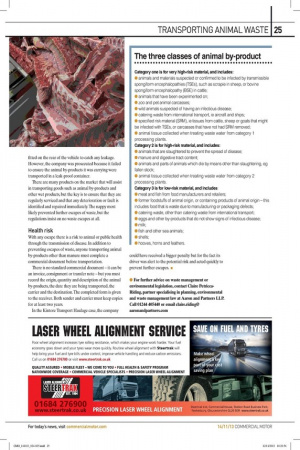The three classes of animal by-product
Page 20

If you've noticed an error in this article please click here to report it so we can fix it.
Category one is for very high-risk material, and includes: • animals and materials suspected or confirmed to be infected by transmissible spongiform encephalopathies (TSEs), such as scrapie in sheep, or bovine spongiform encephalopathy (BSE) in cattle; • animals that have been experimented on; • zoo and pet animal carcasses; • wild animals suspected of having an infectious disease; • catering waste from international transport, ie aircraft and ships; • specified risk material (SRM), ie tissues from cattle, sheep or goats that might be infected with TSEs, or carcasses that have not had SRM removed; • animal tissue collected when treating waste water from category 1 processing plants. Category 2 is for high-risk material, and includes: • animals that are slaughtered to prevent the spread of disease; • manure and digestive tract content; • animals and parts of animals which die by means other than slaughtering, eg fallen stock; • animal tissue collected when treating waste water from category 2 processing plants. Category 3 is for low-risk material, and includes: • meat and fish from food manufacturers and retailers; • former foodstuffs of animal origin, or containing products of animal origin — this includes food that is waste due to manufacturing or packaging defects; • catering waste, other than catering waste from international transport; • eggs and other by-products that do not show signs of infectious disease; • milk; • fish and other sea animals; • shells;
• hooves, horns and feathers.








































